Smart and Satisfying: Easy Healthy Meals for Weight Loss That Make Dinner Delicious and Nutritious
In today’s fast-paced world, finding the balance between eating healthfully and managing a busy lifestyle can feel overwhelming. For those seeking effective, sustainable ways to lose weight without sacrificing taste or nutrition, the concept of preparing easy healthy meals for weight loss offers a practical and rewarding solution. Instead of relying on restrictive fads or highly processed diet products, embracing whole, plant-based foods allows for nourishing the body while enjoying deeply satisfying flavors and textures. This article explores evidence-backed strategies, nutritious recipes, and smart meal planning techniques to help you create healthy dinners for weight loss that are both satisfying and sustainable. Whether you’re looking for meals to make to lose weight, healthy supper ideas for weight loss, or simply good diet meals that fit your lifestyle, you’ll find expert guidance and inspiration rooted in nutritional science.
You may also like: Plant Based Diet vs Standard American Diet: What the Latest Studies Reveal About Long-Term Health Outcomes
The Science Behind Healthy Diet Meals and Sustainable Weight Loss
Weight loss, when approached from a whole-food, plant-based perspective, offers not only short-term benefits but also long-term improvements in metabolic health. Research consistently shows that meals built around vegetables, legumes, whole grains, fruits, nuts, and seeds provide satiety, improve insulin sensitivity, and reduce inflammation—key factors for maintaining a healthy weight. Unlike calorie-restricted diets that often result in nutrient deficiencies, diet meals grounded in whole foods support both weight reduction and optimal health.
One of the core reasons easy meals for weight loss work is their high fiber content. Fiber slows digestion, helps regulate blood sugar levels, and promotes a prolonged feeling of fullness after eating. Many of the healthiest dinner options for weight loss also contain plant-based proteins, such as lentils, chickpeas, or tofu, which are not only satiating but also low in saturated fat. Additionally, incorporating healthy fats from foods like avocado or olive oil helps the body absorb fat-soluble vitamins while adding rich flavor and texture to meals. When evaluating good dinner options for losing weight, it’s crucial to look beyond calorie counts and focus on the overall nutrient density of your meals.
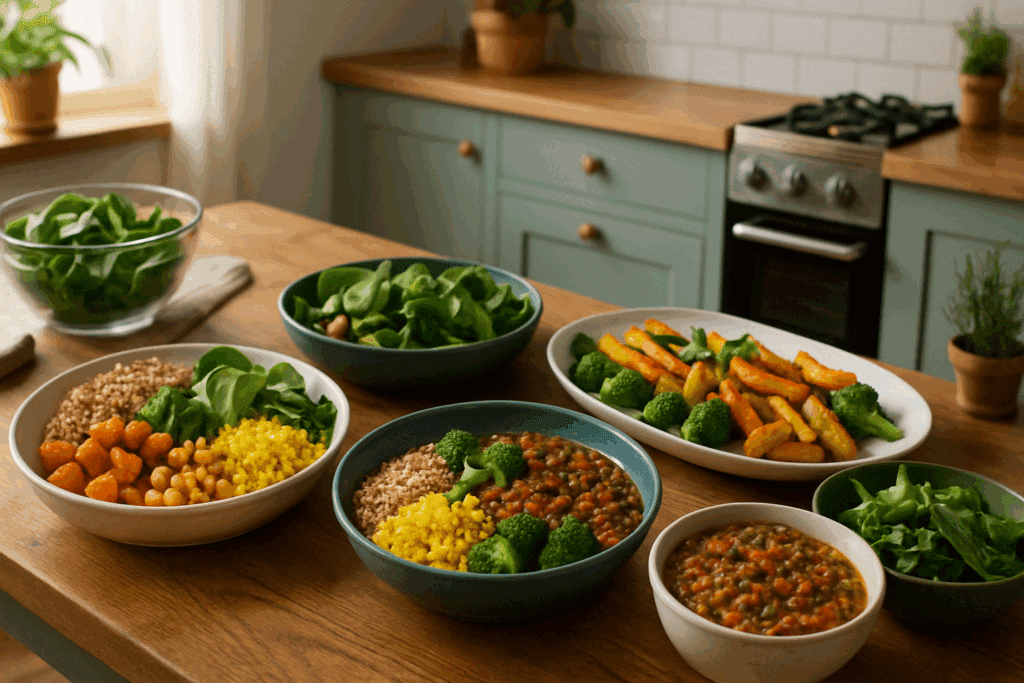
How Plant-Based Diet Dishes Support a Calorie Deficit Without Deprivation
One of the most common challenges people face when attempting to eat meals for cutting fat is the feeling of deprivation. The beauty of a whole-food, plant-based approach lies in its ability to naturally support a calorie deficit without leaving you hungry. This is largely due to the volumetrics principle: plant-based foods tend to be low in calories but high in volume. This means you can enjoy generous portions of diet dishes without exceeding your daily energy requirements.
For instance, a large vegetable stir-fry with tofu, brown rice, and sesame-ginger sauce is rich in fiber, water, and nutrients while remaining low in caloric density. The inclusion of leafy greens, cruciferous vegetables, and colorful bell peppers contributes antioxidants and phytonutrients that protect cellular health. These types of healthy meals for losing weight satisfy the senses with vibrant colors, diverse textures, and deep umami flavors. When meals are satisfying and nutritionally complete, they help curb cravings and reduce the likelihood of late-night snacking or emotional eating.
Smart Meal Planning for Weight Loss Success
When trying to integrate healthy eating ideas to lose weight into your daily routine, planning is a crucial component. Without preparation, it’s easy to fall back on convenience foods that are often high in refined sugars, sodium, and unhealthy fats. Meal planning allows you to intentionally select ingredients that align with your health goals while saving time and money throughout the week.
Start by mapping out your week and identifying windows of time when you can cook. Choose a few versatile recipes that can be prepared in bulk and enjoyed for multiple meals. For example, a hearty lentil and vegetable stew can be portioned for dinner and then repurposed for lunch the next day. Batch-cooked grains, such as quinoa or farro, serve as excellent foundations for build-your-own bowls with roasted vegetables, beans, and tahini dressing. These are ideal ideas for diet food that emphasize ease, variety, and nourishment. When you take control of your meal planning, it becomes easier to create healthy foods and recipes to lose weight that work for your lifestyle.
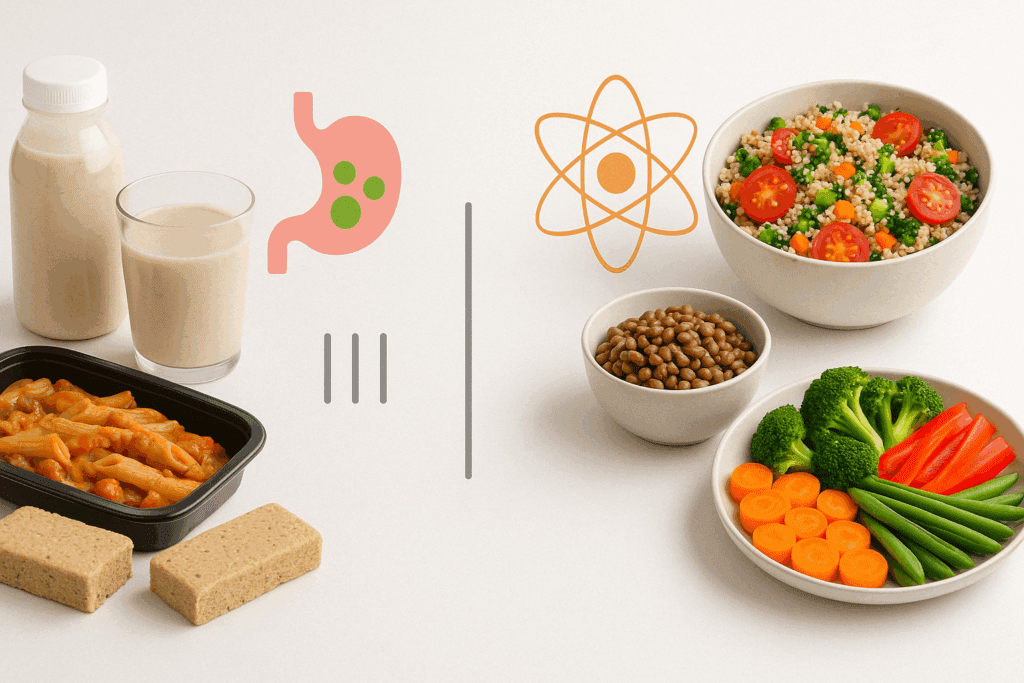
Transforming Classic Comfort Foods into Good Diet Meals
One misconception about healthy diet meals is that they must be bland or boring. In reality, many of your favorite comfort dishes can be reinvented in ways that align with weight loss goals. Instead of traditional lasagna with refined pasta and heavy cheese, try a version made with whole-grain noodles, layers of roasted vegetables, and cashew-based ricotta. Swapping out calorie-dense ingredients for fiber-rich, plant-based alternatives can transform familiar dishes into healthy meals for losing weight without compromising on flavor.
Other examples include using spiralized zucchini instead of spaghetti for pasta dishes, baking instead of frying, and seasoning generously with herbs and spices instead of excess salt or fat. Even something like a creamy curry can become a dinner to lose weight when it’s made with light coconut milk, chickpeas, and a rainbow of vegetables served over brown rice. These small shifts result in easy healthy meals for weight loss that feel indulgent yet contribute to your health.
Understanding Portion Control Without Obsessing Over Calories
For those new to the concept of intuitive eating, the idea of eating without counting calories may feel unfamiliar. However, a focus on whole foods naturally lends itself to better portion control because these foods are more satiating and less processed. By eating slowly, chewing thoroughly, and pausing between bites, you allow your body’s hunger and fullness cues to guide your intake.
Visual cues can also support portion awareness. Fill half your plate with non-starchy vegetables, one-quarter with whole grains, and the remaining quarter with legumes or plant proteins. This balanced plate approach encourages meals for cutting fat while still providing adequate nutrition. By listening to your body and choosing good dinner options for losing weight that are both satisfying and aligned with your health goals, you cultivate a more sustainable relationship with food.
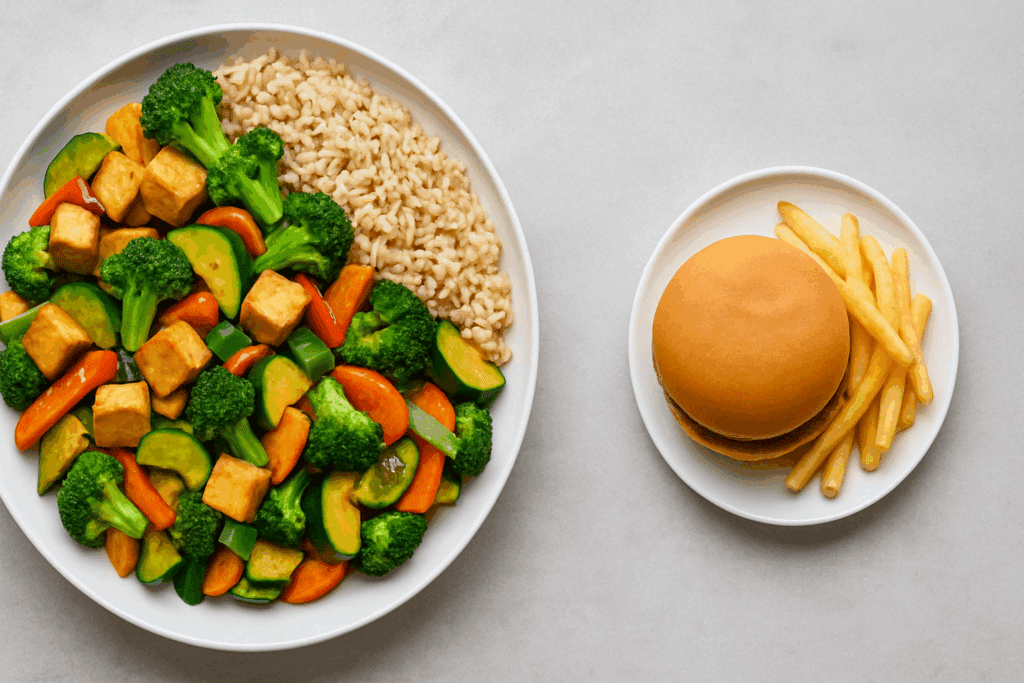
The Role of Macronutrients in Healthy Supper Ideas for Weight Loss
Balancing macronutrients—carbohydrates, protein, and fat—is essential when creating healthy supper ideas for weight loss. Contrary to outdated diet myths, complex carbohydrates such as whole grains, sweet potatoes, and legumes are beneficial for energy and digestion. They provide long-lasting fuel and help regulate blood sugar levels, especially when combined with protein and fat.
Plant-based proteins like edamame, tempeh, lentils, and beans support muscle maintenance and metabolic health. Healthy fats from nuts, seeds, avocados, and olive oil promote hormone balance and brain function. Including all three macronutrients in your dinner for losing weight ensures that your meals are nutritionally complete and deeply satisfying. For instance, a quinoa salad with roasted vegetables, pumpkin seeds, and a lemon-tahini dressing contains each macronutrient and offers a symphony of flavors and textures.
Real-Life Ideas for Diet Food That Satisfies and Nourishes
Creating meals that check both the “satisfying” and “nutritious” boxes is easier than it may seem. Consider a sweet potato and black bean enchilada bake made with whole corn tortillas, homemade salsa, and a light cashew cream drizzle. It’s a crowd-pleaser, reheats beautifully, and aligns with goals for healthy diet meals. Another option might be a Thai-inspired peanut tofu bowl with brown rice, steamed bok choy, shredded carrots, and scallions, topped with a spicy lime-peanut sauce.
When developing dishes to lose weight, always aim for combinations that provide fiber, protein, and healthy fats. A chickpea and spinach curry served with millet, or a roasted cauliflower and lentil bake with fresh herbs and lemon zest, can deliver warmth and comfort while supporting weight loss. These types of easy meals for weight loss don’t require culinary expertise, just thoughtful ingredient choices and an openness to trying new flavor profiles.
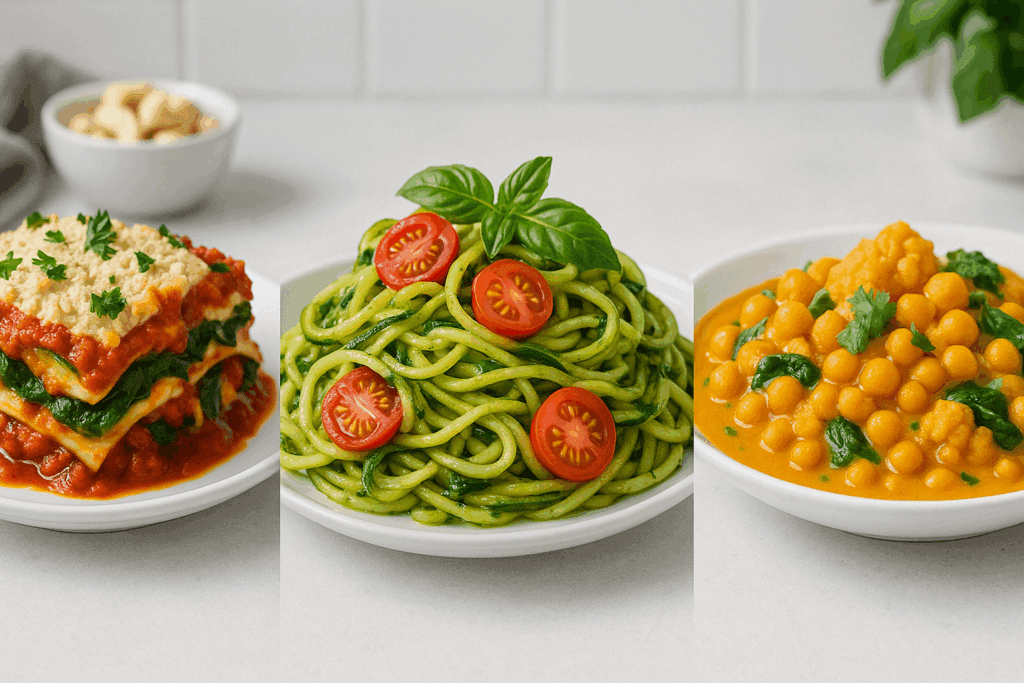
Debunking Myths About Carbs and Fats in Dinner for Losing Weight
Much of the confusion around dinner for losing weight stems from misinformation about carbohydrates and fats. The truth is, not all carbs are created equal. Highly processed carbohydrates, such as white bread, pastries, and sugary cereals, offer little nutritional value and spike blood sugar. In contrast, complex carbohydrates like brown rice, lentils, oats, and starchy vegetables provide sustained energy and vital nutrients.
Similarly, healthy fats are often unfairly maligned. While it’s important to moderate overall fat intake, especially when aiming for meals to make to lose weight, cutting fat entirely is neither realistic nor beneficial. Fats play a critical role in cell structure, hormone production, and nutrient absorption. The key is to include fats from whole food sources like nuts, seeds, and olives, and avoid trans fats or excess saturated fats from processed foods. Understanding these distinctions allows for the creation of healthy foods and recipes to lose weight that are rooted in scientific accuracy, not diet culture myths.
How to Build the Healthiest Dinner for Weight Loss, One Ingredient at a Time
If you’re seeking the healthiest dinner for weight loss, start by focusing on ingredients rather than calories. Choose a base of leafy greens or cruciferous vegetables like broccoli, Brussels sprouts, or kale. Add a serving of whole grains, such as wild rice or bulgur, and include a protein source like black beans, tofu, or lentils. Incorporate healthy fats like sliced avocado, tahini, or toasted walnuts. Finally, bring everything together with flavorful, homemade sauces that use lemon, garlic, herbs, and spices instead of added sugars or preservatives.
This build-a-bowl approach allows endless customization while staying aligned with principles of whole-food, plant-based nutrition. Meals created in this way not only promote weight loss but also support heart health, digestion, and mental clarity. And because they are so customizable, they can evolve with the seasons and reflect your personal taste preferences—an important factor in long-term sustainability. This is what makes these meals ideal for those looking for easy healthy meals for weight loss that go beyond temporary fixes.
Savoring the Process: Why Enjoyment Matters in Every Bite
Too often, healthy eating is framed in terms of restriction, but enjoyment is a critical component of any sustainable lifestyle change. Research shows that when we savor our food, we enhance digestion, satisfaction, and even the bioavailability of nutrients. Taking the time to prepare and enjoy a beautiful, flavorful dinner to lose weight turns each meal into a celebration rather than a chore.
Cooking at home also provides opportunities for mindfulness and creativity. Experimenting with new herbs, international flavor profiles, or plant-based ingredients you haven’t tried before can make the process fun and engaging. Involving loved ones in meal prep can turn dinner into a shared experience, fostering a deeper connection to the food and to each other. This emotional satisfaction is just as important as physical satiety when it comes to maintaining long-term success.
What to Remember When Creating Healthy Meals for Losing Weight
At the heart of any effective weight loss strategy is consistency, not perfection. The goal isn’t to prepare flawless meals every day, but rather to create a pattern of eating that supports your physical and emotional well-being. Healthy supper ideas for weight loss should be accessible, realistic, and adaptable to your needs. Whether you enjoy hearty stews, grain bowls, pasta alternatives, or international flavors, there are endless possibilities for building meals to make to lose weight that never feel like a sacrifice.
By emphasizing fresh, whole ingredients and listening to your body’s cues, you can enjoy a wide array of good diet meals that work with your lifestyle. Keep experimenting, stay curious, and remember that small, consistent steps yield meaningful results over time. The most effective diet dishes are those you enjoy preparing and eating, because they fit seamlessly into the rhythm of your life.
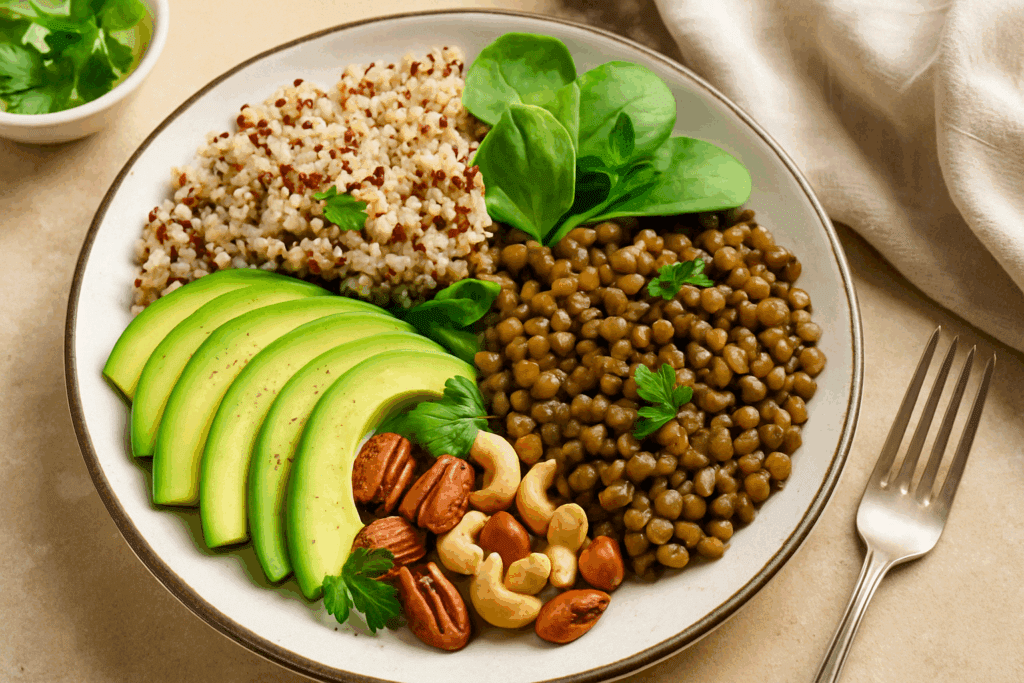
Frequently Asked Questions: Easy Healthy Meals for Weight Loss
1. How can I create satisfying diet meals when I have a busy schedule?
One of the biggest obstacles to preparing healthy diet meals is time. A useful strategy is to batch-cook versatile ingredients that can be mixed and matched throughout the week. For instance, cook a large portion of quinoa or farro, roast a medley of vegetables, and prepare a few plant-based proteins like lentils or baked tofu. These components can be assembled quickly into easy healthy meals for weight loss without requiring daily cooking. When you’re armed with pre-prepped ingredients, it becomes much easier to build good diet meals that are both time-efficient and nutritionally balanced.
2. What are some lesser-known ideas for diet food that help reduce cravings?
While common advice focuses on high-fiber and high-protein foods, emerging evidence suggests that umami-rich plant-based dishes can reduce cravings. Foods like mushrooms, sun-dried tomatoes, and fermented miso add depth to diet dishes, making them more emotionally and physically satisfying. By enhancing flavor, you increase meal enjoyment, which reduces the urge to snack later. These ideas for diet food go beyond just nutrients—they cater to your sensory needs too. Try experimenting with seaweed, tamari, or nutritional yeast for a rich flavor boost in healthy meals for losing weight.
3. Can healthy eating ideas to lose weight also help improve mood and energy?
Absolutely. Nutrient-dense meals stabilize blood sugar, which reduces mood swings and energy crashes. Leafy greens, legumes, and whole grains are rich in B vitamins and magnesium, essential for neurotransmitter production and stress regulation. Meals to make to lose weight often include these ingredients by default, helping to support emotional and mental health in addition to weight goals. A good dinner for losing weight, such as a lentil stew with spinach and barley, offers mood-boosting nutrients that processed meals simply lack. Prioritizing whole, plant-based ingredients supports not only your body composition but also your resilience and focus.
4. How can I stick to healthy supper ideas for weight loss while eating out?
Dining out doesn’t have to derail your efforts if you approach it strategically. Look for dishes to lose weight that emphasize grilled or roasted vegetables, whole grains, and plant-based proteins. You can often modify menu items by asking for extra vegetables, swapping fries for a side salad, or choosing olive oil-based dressings. Even when options are limited, most restaurants can accommodate small requests that align with healthy supper ideas for weight loss. Being proactive with your selections allows you to enjoy your meal without compromising your goals.
5. What are some psychological strategies to make easy meals for weight loss more satisfying?
Mindful eating techniques can significantly enhance satiety. Focused attention while eating, such as putting away screens and chewing slowly, helps your brain register fullness more accurately. Additionally, incorporating ritual—such as plating your food nicely or sitting at a dedicated dining spot—can increase your satisfaction with even the simplest healthy diet meals. This psychological fulfillment makes it easier to commit to good dinner choices for losing weight over the long term. By turning meals into experiences, you’re more likely to feel satisfied and less likely to overeat.
6. How do I know if my dinner for losing weight is nutritionally balanced?
To evaluate whether your dinner supports weight loss and health, consider the macronutrient balance. Your meal should include a source of plant-based protein, such as beans or tofu; fiber-rich carbohydrates like quinoa or sweet potato; and healthy fats from avocado or seeds. Meals for cutting fat are most effective when they also support metabolic health, which means including anti-inflammatory ingredients like greens, garlic, turmeric, or berries. Use the color and texture variety on your plate as a visual cue for nutrient diversity. When in doubt, aim for meals that look like they could be part of a rainbow.
7. Are there ways to use leftovers creatively for healthy meals for losing weight?
Yes—leftovers are one of the most underutilized tools in healthy meal planning. Transform last night’s roasted vegetables into a wrap with hummus, or mix leftover quinoa with greens and citrus vinaigrette for a refreshing grain bowl. Repurposing meals saves time and keeps your diet meals exciting and fresh. For instance, mashed sweet potatoes can be used to thicken a curry or as a base for stuffed bell peppers. Reinventing your leftovers into new healthy foods and recipes to lose weight helps minimize food waste while maximizing convenience.
8. What ingredients are often overlooked in the healthiest dinner for weight loss?
Many people overlook herbs and spices as critical components of meals to make to lose weight. Fresh herbs like parsley, dill, and cilantro add flavor without calories, while spices like cumin, paprika, and ginger offer anti-inflammatory benefits. Fermented foods such as kimchi or sauerkraut can also support gut health, which influences appetite and metabolism. Including a variety of textures—like crunchy seeds, creamy avocado, and crisp greens—also helps create a more satisfying experience. These small but powerful additions elevate good diet meals from basic to extraordinary, all while supporting your weight loss goals.
9. Can I use meal delivery services and still focus on easy healthy meals for weight loss?
Meal delivery services have evolved to accommodate various dietary needs, including plant-based and weight-conscious eating. Look for providers that offer customizable options with a focus on whole, minimally processed ingredients. While not all services are created equal, many now cater to those seeking healthy dinner for weight loss by emphasizing portion control and macro balance. You can also use these services as inspiration for recreating similar dishes at home. With a critical eye and ingredient awareness, meal kits can support your commitment to easy meals for weight loss without sacrificing quality or control.
10. What are some social or family strategies for sticking to good diet meals at dinner time?
Family meals don’t have to compromise your goals. Start by involving everyone in the meal planning process—this creates buy-in and ensures there’s something for everyone. Prepare build-your-own meal formats, like grain bowls or tacos, which allow for customization while keeping the base meal healthy. Dishes to lose weight don’t need to be separate from the family’s dinner; instead, they can serve as the foundation that others can build on with additional toppings or sides. Sharing your journey can also inspire healthier habits in others, turning a solo effort into a collective commitment to health.

Conclusion: Nourishing Your Body and Mind with Smart, Easy Meals for Weight Loss
The journey to healthy weight loss does not require deprivation, bland food, or endless willpower. Instead, it begins with a mindset shift toward nourishment, flavor, and satisfaction. Creating easy healthy meals for weight loss is not just about changing what’s on your plate—it’s about transforming your relationship with food into one rooted in care, knowledge, and joy. Whether you’re preparing a quick weekday dinner or exploring new healthy eating ideas to lose weight, the foundation lies in whole, plant-based ingredients that support your health on every level.
When meals are enjoyable, balanced, and made with intention, they become powerful tools for well-being. You don’t have to choose between health and flavor—you can have both. With the right guidance and a little creativity, every dinner can become the healthiest dinner for weight loss, tailored to your preferences and goals. Embrace the process, trust in your body’s wisdom, and allow yourself the pleasure of eating well. This is the path to sustainable, satisfying weight loss that truly nourishes from the inside out.
Was this article helpful? Don’t let it stop with you. Share it right now with someone who needs to see it—whether it’s a friend, a colleague, or your whole network. And if staying ahead on this topic matters to you, subscribe to this publication for the most up-to-date information. You’ll get the latest insights delivered straight to you—no searching, no missing out.
Further Reading:
19 Easy Dinners for Weight Loss You’ll Want to Make Forever
10 Simple Dinner Ideas for Healthy Eating in Real Life
Recipes for Weight Loss & Diet
Disclaimer
The information contained in this article is provided for general informational purposes only and is not intended to serve as medical, legal, or professional advice. While NewsHealthWatch strives to present accurate, up-to-date, and reliable content, no warranty or guarantee, expressed or implied, is made regarding the completeness, accuracy, or adequacy of the information provided. Readers are strongly advised to seek the guidance of a qualified healthcare provider or other relevant professionals before acting on any information contained in this article. NewsHealthWatch, its authors, editors, and contributors expressly disclaim any liability for any damages, losses, or consequences arising directly or indirectly from the use, interpretation, or reliance on any information presented herein. The views and opinions expressed in this article are those of the author(s) and do not necessarily reflect the official policies or positions of NewsHealthWatch.

